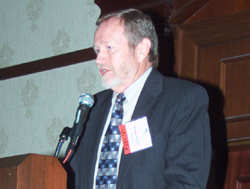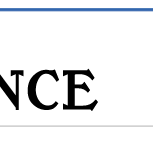"Positioning Beef Industry Allies"
Wayne Purcell, Virginia Tech

Wayne Purcell, ag economist, said producers need to be consumer-driven and change the product offering when consumers change what they want and are willing to pay for. |
Click here to view PowerPoint presentation as a pdf.
Click here to listen to the presentation
You will need Windows Media Player to listen in.
Click here to download a free version.
Visit Purcell's Web site at www.aaec.vt.edu/rilp
The future of the beef business
Cattlemen must develop and understand two themes in order to move the industry forward, said Virginia Tech ag economist Wayne Purcell during the National Angus Conference Sept. 15 at the Hotel Roanoke Conference Center in Roanoke, Va.
First, producers must change the way they do business and the way they interact with others in the industry, Purcell said. Only then can they develop the second theme — becoming consumer-driven.
"In order to be consumer-driven and to continue to enhance demand, you have to be able to change the way you do business and how you affiliate yourselves with your allies and with your partners in the [beef] sector," he told the approximately 300 Angus enthusiasts attending the event.
Purcell said an important part of understanding market trends is understanding what determines demand and how it is measured.
"Demand is not measured by per capita consumption. Per capita consumption measures supply available; it says nothing about the level of demand," he said. Rather, demand is determined by quantity consumed and consumers' willingness to pay.
To increase that, producers should know what drives a consumer to buy beef, and they must be able to change their product offering when consumers change what they want.
"To pay record-high prices, consumers have to like the product, Purcell said. "It's got to perform, and we can't have a product failure rate of 25% as we have had.
The Angus advance has decreased the probability of product failure," he added.
Purcell said the industry's 20-year market slump beginning in the late 1970s, which resulted in a cumulative price decline of approximately 49.8%, was due to the industry's failure to realize consumer desires for a safe, tender, consistent and convenient product. Only when programs like Certified Angus Beef LLC (CAB) began to provide those qualities did demand finally begin to turn around in 1998.
"The future of the industry is tied to the extent to which we go to the consumer," he said. "Consumers are not willing to pay unless they're confident they're going to get a dependable, consistent, high-quality eating experience."
Now that the industry has begun to improve beef quality and offer more consistent, convenient products, Purcell said he foresees a positive outlook for beef in the next six years.
"We'll see more sophisticated coordination, quality control and product innovation," he said. Moving to a contract/alliance system, from the traditional price-driven system, will allow that.
Purcell predicted that in the next few years cow-calf producers would have an opportunity to invest in better genetics, the beef industry would begin to take back lost market share, beef demand would continue to increase, and producers would have a good chance at profits.
He said, "We'll see record-high prices repeated, and that will happen because we're headed into a building phase in the cattle cycle."
by Crystal Albers
|








